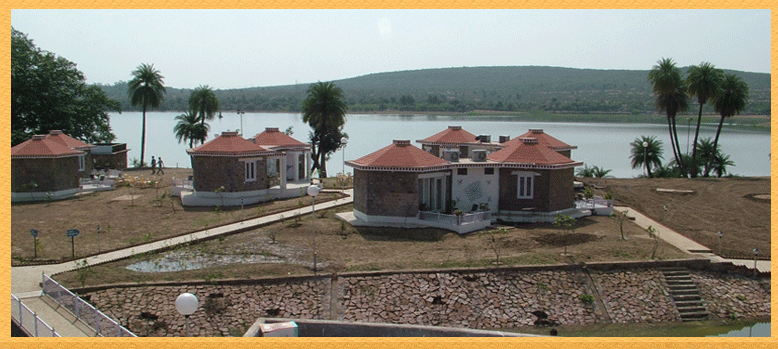At the end of the south-eastern region of Rajasthan, at the end of the Malwa Plateau lies Jhalawar. Rocky but water-laden verdant landscape.
Untypical of Rajasthan, Jhalawar sways with poppy fields and orange laden orchards, which make the landscape, burst into a colour, every winter.
A princely state of the Jhalas, Jhalawar was founded in 1838 A.D., after being severed from Kota by the British.
Pre-historic cave paintings, imposing forts, thickly wooded forests create the right blend of natural and historic wealth in the region.
Spot countless species of birds as you drive past the lush countryside. Exotic varieties of wildlife become companion on your journey into this fascinating land.
The area around Bhawani Mandi is known for contributing a major share to the production of citrus fruits in the country. Do peel one, and enjoy.
Places of interest:-
Garh Palace: The impressive fort in the centre of the town presently houses the Collectorate and other district offices. Some exquisite paintings and mirrors on the walls of 'Zanana Khas' are of particular interest.
Government Museum: One of the oldest museums of Rajasthan established in 1915 A.D., it has a fine collection of paintings, rare manuscripts, idols and beautiful statues of Lakshmi narayan, Vishnu, Krishna, Ardhanarishvar, Natraj and Trimurti.
Bhawani Natya Shala: The most unusual theatre in India. It was constructed in 1921 A.D. where Parsi theatre was performed initially. The building has been recently revived and offers an excellent insight into the theatre art and is situated in the Garh Palace.
Excursions
Raen Basera (6 kms): A picturesque wooden cottage on the banks of the Kishan Sagar pond, it is an idyllic haunt for picnickers. The cottage was originally built elsewhere and later transported to the present location. Amazingly, it still retains much of the original design.
Jhalarapatan (6 kms): The small town is popularly referred to as the 'City of bells'. An entire township resides within the confines of a wall, which was built to protect the trade caravans from pindaries.
A magnificent 10th century Surya Temple (Padam Nath Temple) is the major attraction of the city. The temple has some splendid sculptures as well as, nicely preserved idols of Surya.
Chandrabhaga Temples (7 kms): On the banks of the magnificent Chandrabhaga River stand some splendid 7th century A.D. temples. The intricately carved pillars and arched gateways are fine examples of the temple architecture and craftsmanship. The 11th century A.D. Shantinath Jain temple is also noteworthy with fine murals and exquisite sculptures.
Gagron Fort: The impressive fort, built over several centuries (8th to 18th centuries A.D.), stands witness to many great battles and is surrounded by the tranquil waters of the Ahu and Kali Sindh rivers on the three sides.
A beautiful mausoleum of a Sufi Saint Mitheshah just near the fort is the venue for an annual colourful fair held during the month of Moharram.
Buddhist Caves •and Stupas: The ancient Buddhist caves are located in the village Kolvi. A colossal figure of Buddha and the carved stupas are the most impressive structure in the caves. Buddhist Caves are also located in Vinayaga & Hathiagod village.
Dag (100 kms): Renowned for some 12th century A.D. temples of Dageshwari Mata, Rani ka Maqbara and Kaya Varneshwar Nath at Kyasara. Dag is a fascinating experience in the rustic ambience.
Kakuni (70 kms): Kakuni lies in Baran District. Some ancient temples dot the ruins of this old township. A life-size idol of Lord Ganesha and a Shiva Lingam dating back to the 18th century A.D. are the impressive structures.
Ruins of the Bhimgarh Fort, built by Raja Bhim Deo, lie on the other side of the Parvan river and are worth a visit.
Bhimsagar (24 kms): The dam built on the Ujad river is near the erstwhile capital, Mau Vorda of Khichi Chauhan Rulers. Bhimsagar allows a glimpse of the Rajput and the Mughal architecture in the ruins of palaces, temples and mosques of Mau Vorda.
Atishey Jain Temple, Chandkheri (35 kms): This 17th century temple is a notable example of temple architecture. It also has religious value having Adinath statue, 6 feet tall, in a sitting position. Accommodation and meals are available at reasonable prices in the temple area.
Dolhanpur (5 kms): The ancient ruins of impressive temples extend over an area of 2 kms. Marvellously carved pillars, torans and exquisite sculptures make these temples interesting. Dalhanpur lies on the bank of river Chhapi, where an irrigation dam is being constructed. Dense forests with lush foliage add to the natural beauty of the spot.
Jain Shwetamber Nageshwar Parsvanath Temple, Unnel (150 kms): An important religious Jain pilgrim centre, having a thousand year old Parsvanath statue. Accommodation & meals are available in temple premises at reasonable rates.
Fort of Gangdhar (120 kms): An impressive edifice with the oldest rock inscription of 480 A.D., now displayed at Jhalawar Museum and some marvelously built temples.
TRAVEL INFORMATION
HOW TO REACH JHALAWAR
Air: Nearest airport is Jaipur 345 kms. Kota, 85 kms has an airport, but no flight operates
Rail: Nearest major rail head is Kota, then by taxi or bus (85 kms).
Road: A good network of road connections. Some important distances include Jaipur 335 km, Aimer 292 kms, Kota 85 kms, Bundi 123 kms, Delhi 590 kms, Bhopal 265 kms, Indore 235 kms, Udaipur 445 kms.
Local Transport: Un-metered taxis, auto-rickshaws.
GENERAL INFORMATION
Area: 62.19 Sq. Kms
Altitude: 316 metres
Climate: Mean Max. Mean Min.
Summer: 42.0°C 27.0 °C
Winter: 25.0 °C 9.5 °C
Rainfall: 60-95 cms.
Best season: September- March
Clothing: Summer: Light Tropical
Winter: Woollen
Languages: Rajasthani, Hindi, English
Untypical of Rajasthan, Jhalawar sways with poppy fields and orange laden orchards, which make the landscape, burst into a colour, every winter.
A princely state of the Jhalas, Jhalawar was founded in 1838 A.D., after being severed from Kota by the British.
Pre-historic cave paintings, imposing forts, thickly wooded forests create the right blend of natural and historic wealth in the region.
Spot countless species of birds as you drive past the lush countryside. Exotic varieties of wildlife become companion on your journey into this fascinating land.
The area around Bhawani Mandi is known for contributing a major share to the production of citrus fruits in the country. Do peel one, and enjoy.
Places of interest:-
Garh Palace: The impressive fort in the centre of the town presently houses the Collectorate and other district offices. Some exquisite paintings and mirrors on the walls of 'Zanana Khas' are of particular interest.
Government Museum: One of the oldest museums of Rajasthan established in 1915 A.D., it has a fine collection of paintings, rare manuscripts, idols and beautiful statues of Lakshmi narayan, Vishnu, Krishna, Ardhanarishvar, Natraj and Trimurti.
Bhawani Natya Shala: The most unusual theatre in India. It was constructed in 1921 A.D. where Parsi theatre was performed initially. The building has been recently revived and offers an excellent insight into the theatre art and is situated in the Garh Palace.
Excursions
Raen Basera (6 kms): A picturesque wooden cottage on the banks of the Kishan Sagar pond, it is an idyllic haunt for picnickers. The cottage was originally built elsewhere and later transported to the present location. Amazingly, it still retains much of the original design.
Jhalarapatan (6 kms): The small town is popularly referred to as the 'City of bells'. An entire township resides within the confines of a wall, which was built to protect the trade caravans from pindaries.
A magnificent 10th century Surya Temple (Padam Nath Temple) is the major attraction of the city. The temple has some splendid sculptures as well as, nicely preserved idols of Surya.
Chandrabhaga Temples (7 kms): On the banks of the magnificent Chandrabhaga River stand some splendid 7th century A.D. temples. The intricately carved pillars and arched gateways are fine examples of the temple architecture and craftsmanship. The 11th century A.D. Shantinath Jain temple is also noteworthy with fine murals and exquisite sculptures.
Gagron Fort: The impressive fort, built over several centuries (8th to 18th centuries A.D.), stands witness to many great battles and is surrounded by the tranquil waters of the Ahu and Kali Sindh rivers on the three sides.
A beautiful mausoleum of a Sufi Saint Mitheshah just near the fort is the venue for an annual colourful fair held during the month of Moharram.
Buddhist Caves •and Stupas: The ancient Buddhist caves are located in the village Kolvi. A colossal figure of Buddha and the carved stupas are the most impressive structure in the caves. Buddhist Caves are also located in Vinayaga & Hathiagod village.
Dag (100 kms): Renowned for some 12th century A.D. temples of Dageshwari Mata, Rani ka Maqbara and Kaya Varneshwar Nath at Kyasara. Dag is a fascinating experience in the rustic ambience.
Kakuni (70 kms): Kakuni lies in Baran District. Some ancient temples dot the ruins of this old township. A life-size idol of Lord Ganesha and a Shiva Lingam dating back to the 18th century A.D. are the impressive structures.
Ruins of the Bhimgarh Fort, built by Raja Bhim Deo, lie on the other side of the Parvan river and are worth a visit.
Bhimsagar (24 kms): The dam built on the Ujad river is near the erstwhile capital, Mau Vorda of Khichi Chauhan Rulers. Bhimsagar allows a glimpse of the Rajput and the Mughal architecture in the ruins of palaces, temples and mosques of Mau Vorda.
Atishey Jain Temple, Chandkheri (35 kms): This 17th century temple is a notable example of temple architecture. It also has religious value having Adinath statue, 6 feet tall, in a sitting position. Accommodation and meals are available at reasonable prices in the temple area.
Dolhanpur (5 kms): The ancient ruins of impressive temples extend over an area of 2 kms. Marvellously carved pillars, torans and exquisite sculptures make these temples interesting. Dalhanpur lies on the bank of river Chhapi, where an irrigation dam is being constructed. Dense forests with lush foliage add to the natural beauty of the spot.
Jain Shwetamber Nageshwar Parsvanath Temple, Unnel (150 kms): An important religious Jain pilgrim centre, having a thousand year old Parsvanath statue. Accommodation & meals are available in temple premises at reasonable rates.
Fort of Gangdhar (120 kms): An impressive edifice with the oldest rock inscription of 480 A.D., now displayed at Jhalawar Museum and some marvelously built temples.
TRAVEL INFORMATION
HOW TO REACH JHALAWAR
Air: Nearest airport is Jaipur 345 kms. Kota, 85 kms has an airport, but no flight operates
Rail: Nearest major rail head is Kota, then by taxi or bus (85 kms).
Road: A good network of road connections. Some important distances include Jaipur 335 km, Aimer 292 kms, Kota 85 kms, Bundi 123 kms, Delhi 590 kms, Bhopal 265 kms, Indore 235 kms, Udaipur 445 kms.
Local Transport: Un-metered taxis, auto-rickshaws.
GENERAL INFORMATION
Area: 62.19 Sq. Kms
Altitude: 316 metres
Climate: Mean Max. Mean Min.
Summer: 42.0°C 27.0 °C
Winter: 25.0 °C 9.5 °C
Rainfall: 60-95 cms.
Best season: September- March
Clothing: Summer: Light Tropical
Winter: Woollen
Languages: Rajasthani, Hindi, English



